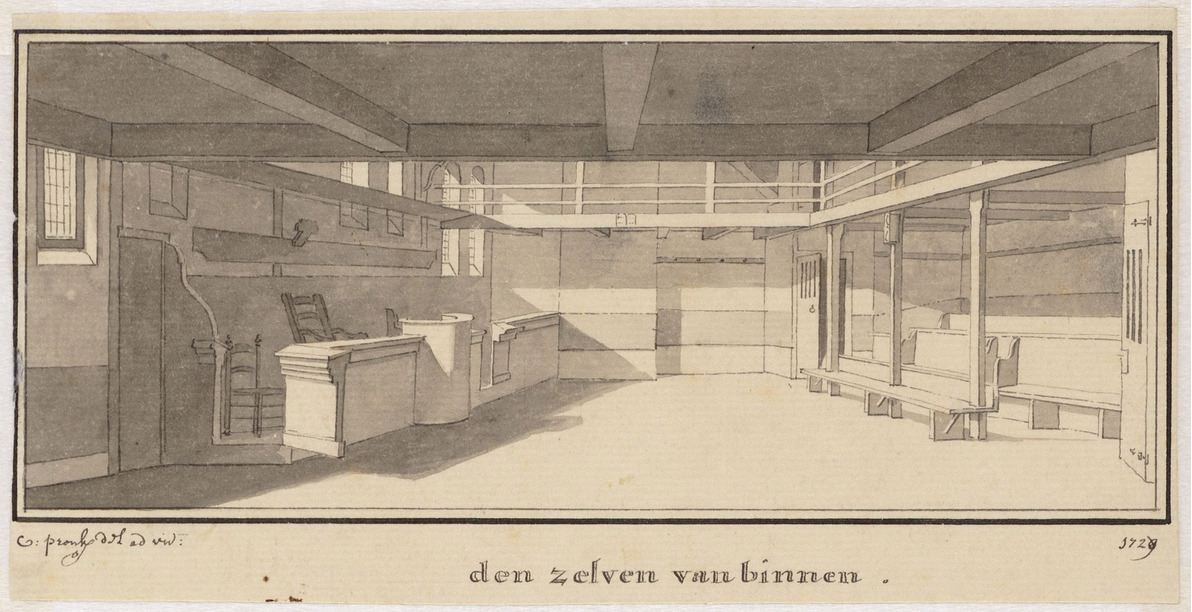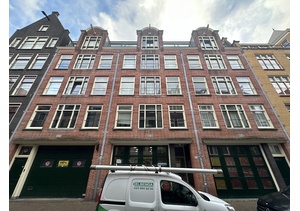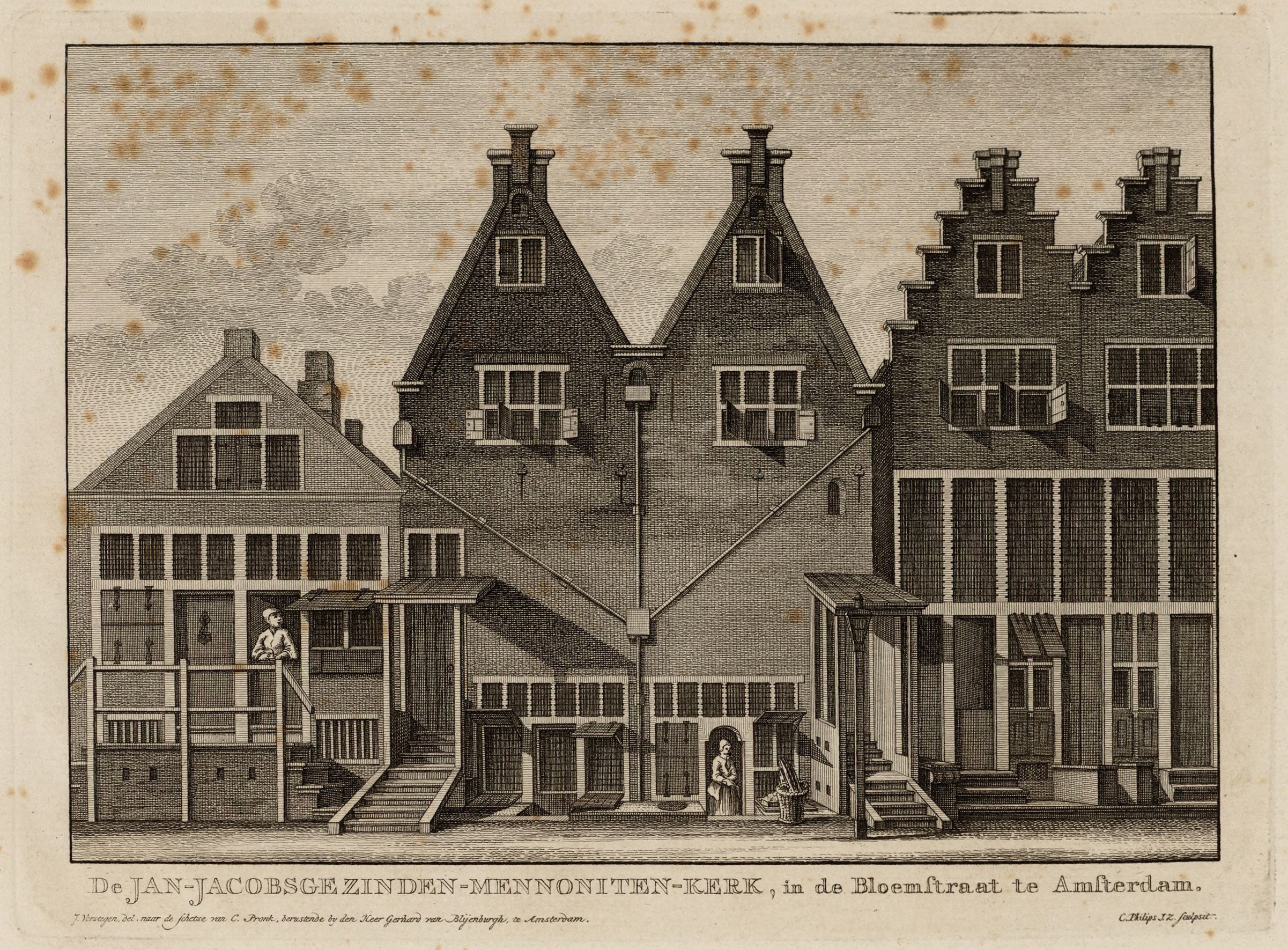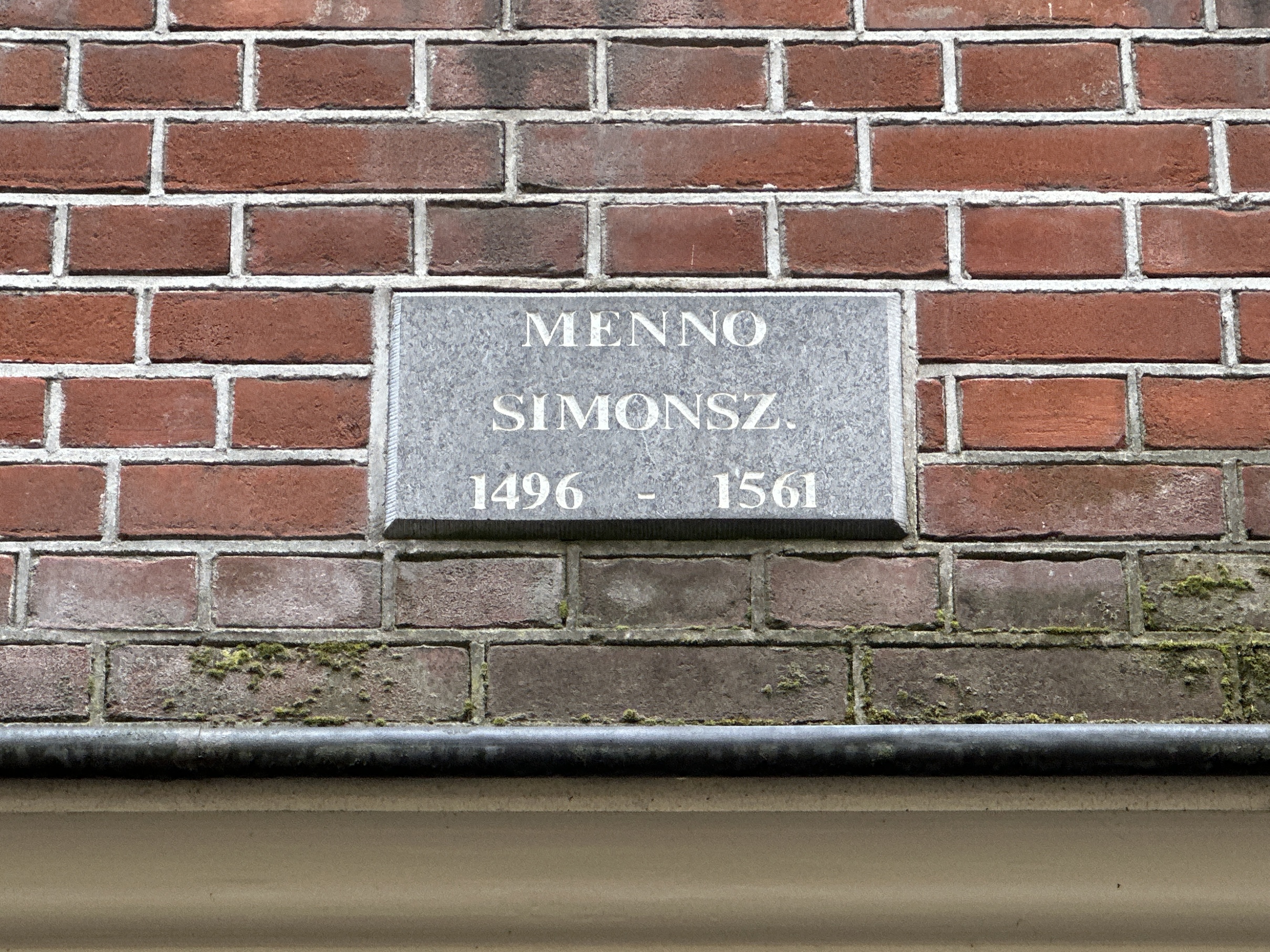A few drawings and prints are all that remain to give an impression of what it once looked like inside the hidden church on the Bloemstraat, where one of Amsterdam’s most conservative Mennonite congregations once gathered to worship.
Location
The Jan Jacobszgezinden
Bloemstraat 49-51
Type
Hidden church
Religious community
Former Mennonite church
Object
Drawing of the interior of the hidden church of the Jan Jacobsgezinde Mennonites
Maker and date
Cornelis Pronk
1729
Visit
The hidden church is demolished. The drawing is in the City Archives Amsterdam
The Jan Jacobszgezinden on the Bloemstraat
The ultra-conservative Jan Jacobszgezinden came into being in Harlingen after a schism in the late-sixteenth century between the Old Frisian Mennonites and the followers of elder Jan Jacobsz. In his eighteenth-century study of Dutch “Doopsgezinden or Mennonites,” S.F. Rues describes this splinter group in his section on the so-called fijne minnisten – the groups who maintained the sharpest degree of separation from the world, and were the strictest in their sober dress, church practices, and application of the ban. Outside of Friesland, the only other gathering places of the Jan Jacobszgezinden were in Hoorn and Amsterdam.
The Amsterdam vermaning was purpose-built behind the gables of two houses on the Bloemstraat sometime during the development of the Jordaan neighbourhood after 1610 and before 1645. Cornelis Pronk (1691-1759), a member of the nearby Arcke Noach, made drawings of the exterior house fronts and the extremely plain interior in 1729, just after the church’s closure. These were later used as the basis for prints by Caspar Philips Jacobsz., and several other artists made copies after his drawings too.
Vermaning
Dutch Mennonites have historically called their churches vermaningen [roughly translated, ‘admonitions’]. This stems from the Mennonite understanding of the congregation as church: congregants were to discern scripture together, and to try and hold each other accountable in their faith and daily lives.
Dutch Mennonite/Doopsgezind subgroups
There were many different branches of Dutch Mennonites in the early modern period, including Old and Young Flemish, Old and Young Frisians, High Germans, Waterlanders, and other splinter groups. Mergers also occurred (eg., the Flemish, Frisians, High Germans, and later also Waterlanders, united with the Flemish at the Kerk bij ’t Lam). As of the 1660s, groups also redivided themselves as Lamists or Zonists (see Lammerenkrijgh). Nearly all groups reunited in Amsterdam in 1801, and nationally in 1811, forming the Algemene Doopsgezinde Sociëteit (ADS).
Fijne minnisten
Name for the strictest Mennonite splinter groups. These included the Groninger Old Flemish, Danziger Older Flemish, and the Jan Jacobszgezinden, among some others. They stood in contrast to the so-called Grove Mennisten (Common Mennonites/Doopsgezinden): the Waterlanders, Young Flemish, and Young Frisians (among others), and later the Lamists and Zonists. These labels were mainly used in the eighteenth and early nineteenth century in the Netherlands and in Prussia.
Pronk depicts the unadorned room from beneath the three-sided balcony. There is no organ; this would have been deemed too worldly. On the main floor, at the left, we see the bench for the deacons and a larger and smaller chair for the preacher and, most likely, the cantor. In middle of the room, there is open space for chairs for the women and at the back their are benches for the men.
Between 1725 and 1728, the congregation had grown so small that they decided to join the united Lam and Toren congregation. A document from the merger indicates the assets that would be transferred to the larger congregation and includes the names of the 16 members who planned to transfer membership – three of whom signed by way of a “X,” meaning they did not know how to write. Four other members protested, obtaining a notarial declaration indicating their desire to have the Bloemstraat building returned to them in 1730. Their efforts were unsuccessful.
The property was converted into houses in the eighteenth century. One building was demolished in the 1930s, while the other one, together with the house next to it, was torn down in 1961. The buildings on the site today are no longer properties of Doopsgezind Amsterdam, but four small commemorative plaques from the year 2000, which read “BIJ HET LAM III ANNO 2000,” “MENNO SIMONSZ. 1496-1561,” “Oude Friezen A⁰ MM,” and “III Mennonieten,” offer a reminder of the former Mennonite ownership of this site.
Deacon (Mennonite/Doopsgezind)
Deacons were originally appointed to care for the poor and needy of the congregation. However, in the Dutch context, the role was eventually merged with that of church board member. Deacons (and present-day, church board members) participate in aspects of pastoral care and assist with administering baptism and communion. Historically, they also assisted with foot-washing, where that was still practiced; furthermore, they managed church discipline, the ban, and mediation between members.
Doopsgezind Amsterdam (formerly VDGA)
Amsterdam’s Mennonite congregation is known today as Doopsgezind Amsterdam. After centuries of divisions and schisms among the Mennonites, during which time the more conservative groups tended to prefer the name Mennoniet [Mennonite] while the more progressive groups went by Doopsgezind [“Baptism community” or “Baptism-minded”], the congregations united in 1801 as the Verenigde Doopsgezinde Gemeente van Amsterdam (VDGA) [United Mennonite Congregation of Amsterdam]. Today, Doopsgezind Amsterdam is comprised of the Singelkerk (at the 17th-century Kerk bij ’t Lam location) and the 19th-century Meerpadkerk in Noord.
Nina Schroeder-van 't Schip
Independent Scholar, Art Historian & Mennonite Heritage Specialist
Last edited
October 22, 2025
De kerk van de Jan Jacobsgezinden, Pronk, Cornelis, 1729, tekening. Collection Van Eeghen: drawings. City Archive Amsterdam.
Exterior: photography Our Lord in the Attic Museum.
Jobsgezinden-Mennonite-Kerk, in de Bloemstraat te Amsterdam, Philips Jacobsz., Caspar (printmaker), after Jacobus Verstegen and Cornelis Pronk, 1780, print. Collection City Archive Amsterdam: drawings and prints.
Commemorative plaque at the site of the former church of the Jan Jacobsgezinden, unknown maker.
Bakker, E. Fleurbaay en A.W. Gerlagh, De verzameling Van Eeghen: Amsterdamse tekeningen (1600-1950) (Zwolle: Uitgeverij Waanders, 1988) 138-139.
Lambour, Ruud, “Doopsgezinde gemeenten te Amsterdam in de zeventiende en achttiende eeuw,” Amstelodamum 100-1 (2013) 25-38, 35-36.
Rues, S. F., Tegenwoordige staet der Doopsgezinden of Mennoniten, in de Vereenigde Nederlanden: waeragter komt een berigt van de Rynsburgers of Collegianten: beide ter vertooninge van de leer, uiterlyken toestand, en godsdienstige gebruiken dezer kerkelyke genootschappen,; nevens een verhael wegens den oorsprong en voortgang van de jongstleden geschillen der eerstgemelde, met de leeraers der Gereformeerde Kerke (Amsterdam: By F. Houttuyn, 1745) 8-13.
Welcker, A., “Amsterdamse Doopsgezinden in de achttiende eeuw,” Doopsgezinde Bijdragen 16 (1990) 177-226, 189-193.
Online sources
Jacobsz, Jan (1542-1612). Global Anabaptist Mennonite Encyclopedia Online.
Last visited 15-10-2025
Fijne mennisten. Global Anabaptist Mennonite Encyclopedia Online.
Last visited 15-10-2025








